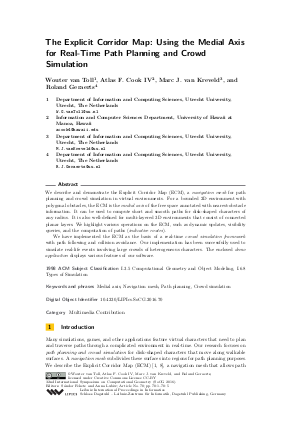The Explicit Corridor Map: Using the Medial Axis for Real-Time Path Planning and Crowd Simulation
Authors Wouter van Toll, Atlas F. Cook IV, Marc van Kreveld, Roland Geraerts
-
Part of:
Volume:
32nd International Symposium on Computational Geometry (SoCG 2016)
Part of: Series: Leibniz International Proceedings in Informatics (LIPIcs)
Part of: Conference: Symposium on Computational Geometry (SoCG) - License:
 Creative Commons Attribution 3.0 Unported license
Creative Commons Attribution 3.0 Unported license
- Publication Date: 2016-06-10
File

PDF
LIPIcs.SoCG.2016.70.pdf
- Filesize: 0.57 MB
- 5 pages
Document Identifiers
Subject Classification
Keywords
- Medial axis
- Navigation mesh
- Path planning
- Crowd simulation
Metrics
- Access Statistics
-
Total Accesses (updated on a weekly basis)
0Document
0Metadata
Abstract
We describe and demonstrate the Explicit Corridor Map (ECM), a navigation mesh for path planning and crowd simulation in virtual environments. For a bounded 2D environment with polygonal obstacles, the ECM is the medial axis of the free space annotated with nearest-obstacle information. It can be used to compute short and smooth paths for disk-shaped characters of any radius. It is also well-defined for multi-layered 3D environments that consist of connected planar layers. We highlight various operations on the ECM, such as dynamic updates, visibility queries, and the computation of paths (indicative routes). We have implemented the ECM as the basis of a real-time crowd simulation framework with path following and collision avoidance. Our implementation has been successfully used to simulate real-life events involving large crowds of heterogeneous characters. The enclosed demo application displays various features of our software.
Cite As Get BibTex
Wouter van Toll, Atlas F. Cook IV, Marc van Kreveld, and Roland Geraerts. The Explicit Corridor Map: Using the Medial Axis for Real-Time Path Planning and Crowd Simulation. In 32nd International Symposium on Computational Geometry (SoCG 2016). Leibniz International Proceedings in Informatics (LIPIcs), Volume 51, pp. 70:1-70:5, Schloss Dagstuhl – Leibniz-Zentrum für Informatik (2016)
https://doi.org/10.4230/LIPIcs.SoCG.2016.70
BibTex
@InProceedings{vantoll_et_al:LIPIcs.SoCG.2016.70,
author = {van Toll, Wouter and Cook IV, Atlas F. and van Kreveld, Marc and Geraerts, Roland},
title = {{The Explicit Corridor Map: Using the Medial Axis for Real-Time Path Planning and Crowd Simulation}},
booktitle = {32nd International Symposium on Computational Geometry (SoCG 2016)},
pages = {70:1--70:5},
series = {Leibniz International Proceedings in Informatics (LIPIcs)},
ISBN = {978-3-95977-009-5},
ISSN = {1868-8969},
year = {2016},
volume = {51},
editor = {Fekete, S\'{a}ndor and Lubiw, Anna},
publisher = {Schloss Dagstuhl -- Leibniz-Zentrum f{\"u}r Informatik},
address = {Dagstuhl, Germany},
URL = {https://drops.dagstuhl.de/entities/document/10.4230/LIPIcs.SoCG.2016.70},
URN = {urn:nbn:de:0030-drops-59622},
doi = {10.4230/LIPIcs.SoCG.2016.70},
annote = {Keywords: Medial axis, Navigation mesh, Path planning, Crowd simulation}
}
Author Details
References
-
R. Geraerts. Planning short paths with clearance using Explicit Corridors. In Proceedings of the IEEE International Conference on Robotics and Automation, pages 1997-2004, 2010.

-
P. Hart, N. Nilsson, and B. Raphael. A formal basis for the heuristic determination of minimum cost paths. IEEE Transactions on Systems Science and Cybernetics, 4(2):100-107, 1968.

-
M. Held. VRONI and ArcVRONI: Software for and applications of Voronoi diagrams in science and engineering. In Proceedings of the 8th International Symposium on Voronoi Diagrams in Science and Engineering, pages 3-12, 2011.

-
K.E. Hoff III, T. Culver, J. Keyser, M. Lin, and D. Manocha. Fast computation of generalized Voronoi diagrams using graphics hardware. International Conference on Computer Graphics and Interactive Techniques, pages 277-286, 1999.

-
D.T. Lee and R.L. Drysdale III. Generalization of Voronoi diagrams in the plane. SIAM Journal on Computing, 10(1):73-87, 1981.

-
F. Preparata. The medial axis of a simple polygon. In Mathematical Foundations of Computer Science, volume 53, pages 443-450. Springer, 1977.

-
W. van Toll, N. Jaklin, and R. Geraerts. Towards believable crowds: A generic multi-level framework for agent navigation. In ASCI.OPEN, 2015.

-
W.G. van Toll, A.F. Cook IV, and R. Geraerts. Navigation meshes for realistic multi-layered environments. In Proceedings of the IEEE/RSJ International Conference on Intelligent Robots and Systems, pages 3526-3532, 2011.

-
W.G. van Toll, A.F. Cook IV, and R. Geraerts. A navigation mesh for dynamic environments. Computer Animation and Virtual Worlds, 23(6):535-546, 2012.

